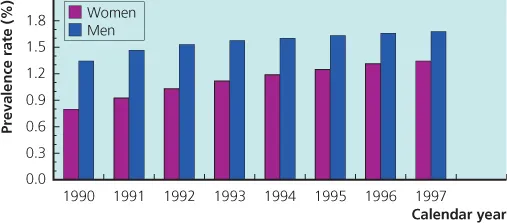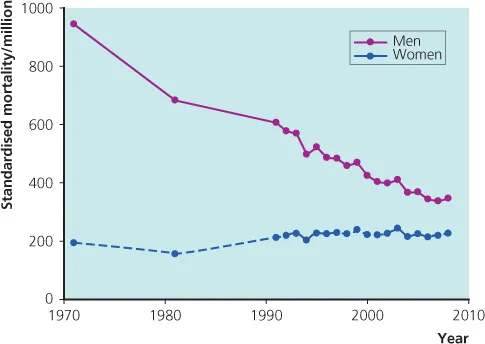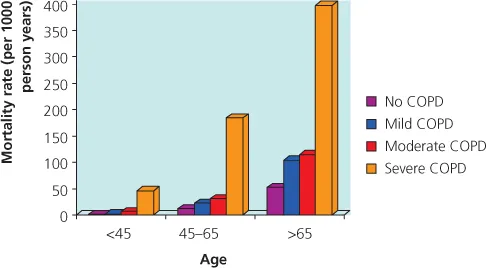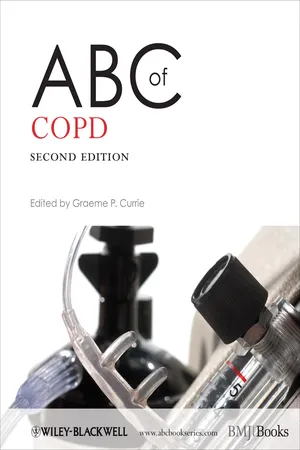![]()
1
Definition, Epidemiology and Risk Factors
Graham S. Devereux
Division of Applied Health Sciences, University of Aberdeen, Aberdeen, UK and Aberdeen Royal Infirmary, Aberdeen UK
Overview
- Chronic obstructive pulmonary disease (COPD) is characterised by largely irreversible airflow obstruction and an abnormal inflammatory response within the lungs
- It is the fourth leading cause of death in the United States and Europe
- Cases of known COPD are likely to only represent the ‘tip of the iceberg’ with as many individuals undiagnosed
- Other conditions also cause progressive airflow obstruction and these need to be differentiated from COPD
- COPD is usually caused by cigarette smoking, but pipe, cigar and passive smoking, indoor and outdoor air pollution, occupational exposures, previous tuberculosis and repeated early life respiratory tract infections have all been implicated in its development
- The prevalence of COPD in never smokers (estimated to be between 25 and 45% worldwide) is higher than previously thought; the use of biomass fuel (mainly in developing countries) is one of the main risk factors
Definition
Chronic obstructive pulmonary disease (COPD) is a progressive disease characterised by airflow obstruction and destruction of lung parenchyma. The current definition as suggested by the American Thoracic and European Respiratory Societies is as follows:
COPD is a preventable and treatable disease state characterised by airflow limitation that is not fully reversible. The airflow limitation is usually progressive and associated with an abnormal inflammatory response of the lungs to noxious particles or gases, primarily caused by cigarette smoking. Although COPD affects the lungs, it also produces significant systemic consequences.
COPD is the preferred term for the airflow obstruction associated with the diseases of chronic bronchitis and emphysema (Box 1.1). A number of other conditions are associated with poorly reversible airflow obstruction—for example, cystic fibrosis, bronchiectasis and obliterative bronchiolitis. These conditions need to be considered in the differential diagnosis of obstructive airway disease, but are not conventionally covered by the definition of COPD. Although asthma is defined by variable airflow obstruction, there is evidence that the airway remodelling processes associated with asthma can result in irreversible progressive airflow obstruction that fulfils the definition for COPD. Because of the high prevalence of asthma and COPD, these conditions co-exist in a sizeable proportion of individuals resulting in diagnostic uncertainty.
Box 1.1 Definitions of conditions associated with airflow obstruction
- COPD is characterised by airflow obstruction. The airflow obstruction is usually progressive, not reversible and does not change markedly over several months. The disease is predominantly caused by smoking.
- Chronic bronchitis is defined as the presence of chronic productive cough on most days for 3 months, in each of 2 consecutive years, in a patient in whom other causes of productive cough have been excluded.
- Emphysema is defined as abnormal, permanent enlargement of the distal airspaces, distal to the terminal bronchioles, accompanied by destruction of their walls and without obvious fibrosis.
- Asthma is characterised by reversible, widespread and intermittent narrowing of the airways.
Epidemiology
Prevalence
The prevalence of COPD varies considerably between epidemiological surveys. While this reflects the variation in the prevalence of COPD between and within different countries, differences in methodology, diagnostic criteria and analytical techniques undoubtedly contribute to disparities between studies.
The lowest estimates of prevalence are usually based on self-reported or doctor-confirmed COPD. These estimates are usually 40–50% of the prevalence rates derived from spirometric indices. This is because COPD is underdiagnosed due to failure to recognise the significance of symptoms and relatively late presentation of disease (Figure 1.1). Estimates of the prevalence of spirometric-defined COPD using UK criteria are less than the estimates based on European and US criteria (Chapter 4).
In the United Kingdom, a national study reported that 10% of males and 11% of females aged 16–65 years had an abnormally low forced expiratory volume in 1 second (FEV1). Similarly, in Manchester, non-reversible airflow obstruction was present in 11% of subjects aged >45 years, of whom 65% had not been diagnosed with COPD. In Salzburg, Austria, doctor-confirmed COPD was reported by 5.6% of adults aged ≥40 years in a population survey; however, on evaluation using spirometric indices, 10.7% fulfilled UK criteria and 26.1% fulfilled European/US criteria. In the United States, the reported prevalence of airflow obstruction with an FEV1 < 80% predicted was 6.8%, with 1.5% of the population having an FEV1 < 50% and 0.5% of the population having more severe airflow obstruction (FEV1 < 35% predicted). As in the United Kingdom, around 60% of subjects with airflow obstruction had not been formally diagnosed with COPD.
In England and Wales, it has been estimated that there are about 900,000 patients with diagnosed COPD. However, after allowing for underdiagnosis, the true number of individuals is likely to be about 1.5 million, although a figure as high as 3.7 million has been suggested. The mean age of diagnosis in the United Kingdom is around 67 years, and the prevalence of COPD increases with age (Figure 1.2). It is also more common in males and is associated with socio-economic deprivation. In the United Kingdom, the prevalence of COPD in females is increasing (Figures 1.3 and 1.4). For example, it was considered to be 0.8% in 1990 and had risen to 1.4% in 1997. In males, the prevalence appears to have plateaued since the mid-1990s. Similar trends have been reported in the United States. These time trends in prevalence probably reflect the gender differences in cigarette smoking since the 1970s.
Mortality
COPD is the fourth leading cause of death in the United States and Europe. Globally, COPD was ranked the sixth most common cause of death in 1990; however, with increases in life expectancy and cigarette smoking, particularly in developing countries, it is expected that COPD will be the third leading cause of death worldwide by 2020. In the United Kingdom in 2008, there were approximately 25,000 deaths due to COPD; 13,000 of these deaths were in males and 12,000 in females. These figures suggest that COPD underlies 4.9% of all deaths (5.4% of male deaths and 4.4% of female deaths) in the United Kingdom.
In the United Kingdom, over the last 30 years, mortality rates due to COPD have fallen in males and risen in females. However, it seems likely that in the near future, there will be no gender difference. In the United States, the most recent data between 2000 and 2005 suggest that 5% of deaths are a consequence of COPD. Although overall, the age-standardised mortality rate was stable at about 64 deaths per 100,000, the death rate in males fell from 83.8/100,000 in 2000 to 77.3/100,000 in 2005 and increased in females from 54.4/100,000 to 56.0/100,000.
Mortality rates increase with age, disease severity and socio-economic disadvantage (Figure 1.5). On average, in the United Kingdom, COPD reduces life expectancy by 1.8 years (76.5 vs 78.3 years for controls); mild disease reduces life expectancy by 1.1 years, moderate disease by 1.7 years and severe disease by 1.4 years.
Morbidity and Economic Impact
The morbidity and economic costs associated with COPD are very high, generally unrecognised and more than twice that associated with asthma. The impact on quality of life is particularly high in patients with frequent exacerbations, although even those with mild disease have an impaired quality of life.
In the United Kingdom, emergency hospital admissions for COPD have steadily increased as a percentage of all admissions from 0.5% in 1991 to 1% in 2000. In 2002/2003, there were 110,000 hospital admissions for an exacerbation of COPD in England with an average duration of stay of 11 days, accounting for 1.1 million bed days. At least 10% of emergency admissions to hospital are as a consequence of COPD and this ...







